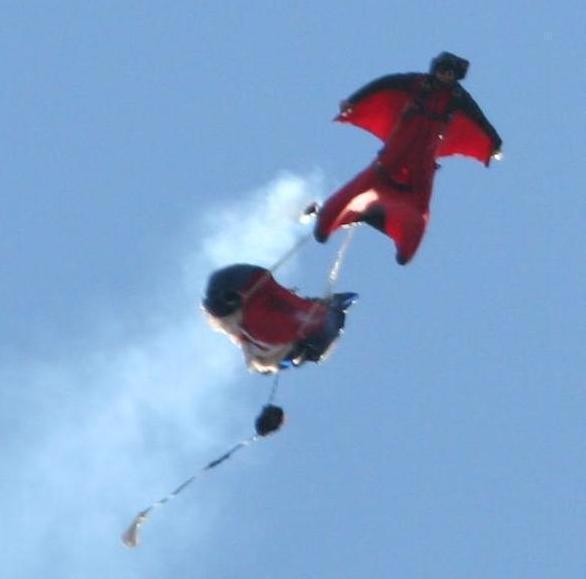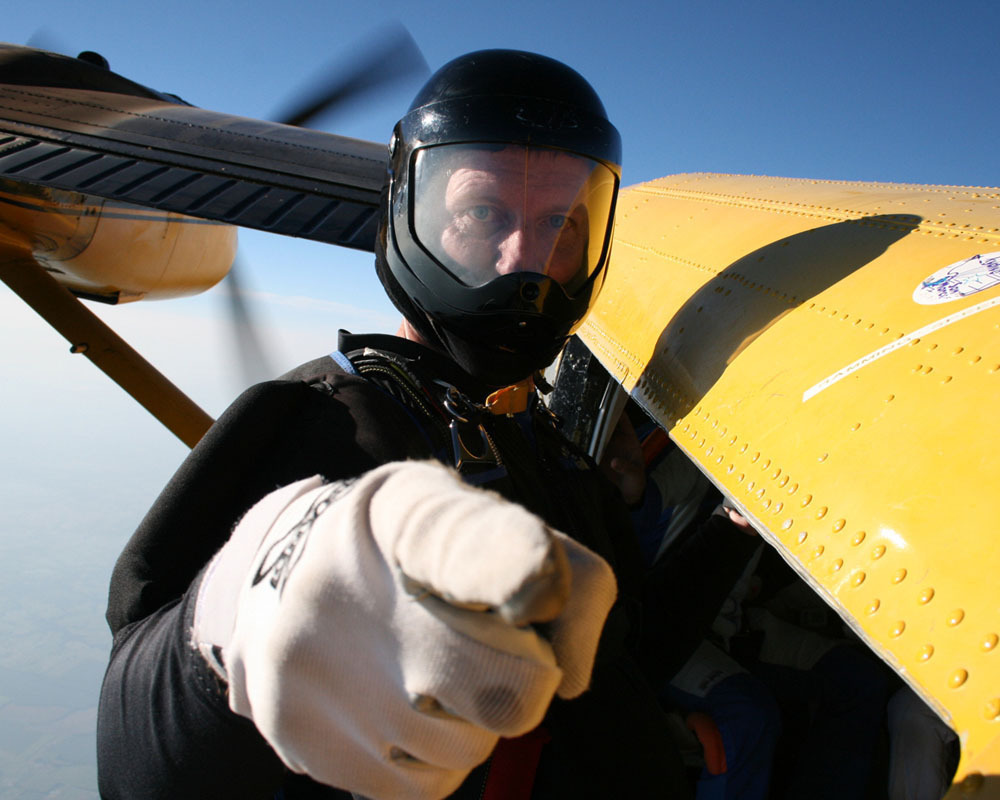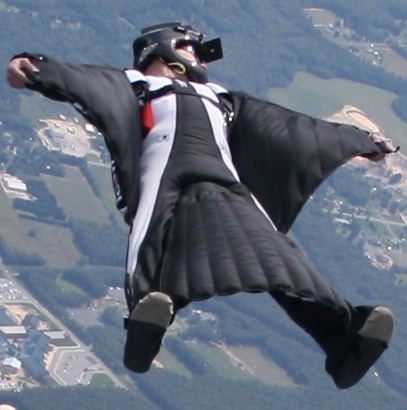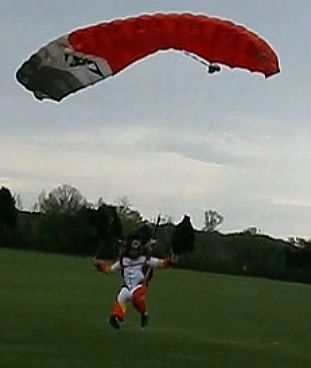Recommended Posts
voodew1 0
For that matter with 5000 jumps why do you need to release the toggles after the brakes have been unstowed --- as for the booties thing - why do you need to take them off --- all of my bootie suits are just fine after hundreds of jumps with them left off -- as for the slider well thats 2 seconds 5 max
the only time I can see that hands need to come out of the toggles is if the canopy doesn't pass control checks and a cutaway must happen
I am not afraid to take my hands out of the toggles but I don't see why you must (I do it to get a radio out of my pocket if my student is flying the wrong direction but that is it)
The pimp hand is powdered up ... say something stupid
tetra316 0
I let go of my toggles every now and again to just fly and steer with my harness. I don't have velcro and never have an issue with regrabbing the toggles. I took a canopy course with Brian Germain a couple years ago and if I'm not mistaken he recommended doing this to get a better feel for your canopy and its characteristics.
Personally I don't understand either why people are so freaked out about letting go of their toggles. Provided of course you grab them again before you cutaway altitude just in case ![]()
DanG 1
In response to someone else, I don't agree that you should teach student that riser maneuvers are done with toggles out of your hands. The rear riser turns that may save you are probably going to happen at a low altitude where letting go of the toggles is frankly stupid (yes, unless you are doing a freestyle swoop, nitpickers). And I've run into more than one student who thought they were supposed to let go of the toggles when doing riser turns. Again, not a good idea.
Sure, let go of your toggles if you need to, I just don't generally see the need.
- Dan G
I searched the SIM pdf for "toggles" and found numerous references. I found references to keeping hands in the toggles while performing riser maneuvers, but nowhere did I find any guidance on keeping hands in toggles once released.
John
QuoteThe rear riser turns that may save you are probably going to happen at a low altitude where letting go of the toggles is frankly stupid (yes, unless you are doing a freestyle swoop, nitpickers).
Or on opening or right after opening after "tracking" like a 30 jump jumper. Before they have a chance to even pick up their toggles.
DanG 1
QuoteOr on opening or right after opening after "tracking" like a 30 jump jumper. Before they have a chance to even pick up their toggles.
Oh, I totally agree. I think students should practice riser turns with toggles stowed and unstowed. However, if the toggles are already unstowed, I advise them to keep them in their hands unless they need to cutaway. When I run across a student that is letting go of their toggles after unstowing them, I make sure they know the disadvantages, which to answer the OP are:
1. It may be difficult, especially with velcroless toggles or when wearing gloves, to get your hands back in.
2. If you find yourself in a potential collision situation you do not have access to the turning technique you are most familiar with.
3. If you encounter turbulence you may wish to use toggle input to reinflate a partially collasped wing.
There may be other disadvantages. Some people may disagree with these. The OP asked what is being taught. If someone can convince me that other factors need to be considered, then I'm certainly open to looking at it from another perspective.
- Dan G
Fast 0
Where troubles melt like lemon drops Away above the chimney tops That's where you'll find me.
Swooping is taking one last poke at the bear before escaping it's cave - davelepka
mdrejhon 8
Reading Brian Germain's Parachute and its Pilot, has given me a habit of loosening my chest strap. Along with deep brakes (if flying downwind) and lifting legs, it has allowed me to return to the dropzone (just on time for 1000ft landing pattern, or at least close enough to get a landing pattern above an adacent farmfield that I'm able to walk from without the embarassment of a ride) from a really long multiple-kilometer spot, more than once... You really can't always do spotting with bigways and sometimes the climbout takes WAY too longQuoteThis statement was made by a couple of folks in the "loosen the chset strap" thread in General.
However, I sometimes take the toggles and realize the spot is long, and then I have time to loosen my chest strap. So I just hold both toggles in one hand while I loosen with the other. I'm able to loosen my chest strap with one hand.
I never intentionally let go of my toggles -- don't want them getting stuck.
Reginald 0
Second, I’ve seen a number of people let go of their toggles (including a student on his A license check out dive) and then the toggles get tangled. Then they pick them back up and pull down on them tying a knot in the brake line. Now they may have a cutaway. I think this is due to having the toggles pulled down and letting them “pop” back up and over when they initially let go of them. I’ve got no issue with an experienced skydiver letting go of toggles momentarily for a good reason, but for a student I don’t see any need and advise against it. I just don’t see any benefit to letting them go and do see some real potential drawbacks.
On a personal note, after deployment and clearing my airspace, I spend about 3 seconds opening my full face, collapsing my slider and loosing my chest strap a couple of inches and then unstow my toggles. I never let go of the toggles after that. If I’ve got to use my toggles in a hurry before getting around to that stuff, I can do all of the above with the toggles in my hands – albeit with some added inconvenience. The only time I can think that I’ve let go of my toggles after I’ve unstowed them is on demo type jumps where I need to confirm I’ve got a good canopy before unstowing a flag or something that takes two unencumbered hands. And then I’m very careful about letting go of the toggles such that they won’t get entangled with anything.
rehmwa 2
QuoteI think this is due to having the toggles pulled down and letting them “pop” back up and over when they initially let go of them
.
.
.
I’m very careful about letting go of the toggles such that they won’t get entangled with anything.
OK - now I understand the issue of the thread. I'm 100% in agreement with slotperfect's post
1 - I don't think one should ever just "drop" the toggles. That's silly. They could flip anywhere that way.
2 - It's very easy to put the toggles up in a controlled fashion. Easiest with velcro, but even with the stiffener one can push that into it's pocket very easily.
3 - worse case, you put your hands all the way up and then release them while against the line guide and they won't go anywhere. It's takes no less time than just 'dropping' them IMO.
4 - Lastly, EYEBALLS, if someone can grab their toggles and NOT LOOK at the lines before pulling them down, then they deserve the "knot in the brake line" you mentioned.
I normally do all my preps (visor, chest strap, etc) before taking my toggles. I can avoid a post opening issue, or any normal traffic, with riser inputs.
But I'm not one bit worried if I have to take my hands out of my toggles. I'll stow the toggles if I forgot the chest strap rather than keep them in my hands.
People need to do more CrW - a lot of canopy paranoia would go away if that happened.
...
Driving is a one dimensional activity - a monkey can do it - being proud of your driving abilities is like being proud of being able to put on pants
Reginald 0
QuotePeople need to do more CrW - a lot of canopy paranoia would go away if that happened.
I would but I only own 2 hook knives.
billvon 3,070
QuoteI teach that you shouldn't take your hands out of the toggles unless you have something more important to do
I am totally in agreement with that statement . . . it was the necer part that peaked my interest.
John
peggs82 0
Quote
People need to do more CrW - a lot of canopy paranoia would go away if that happened.
For real people.... It will fly straight... Your toggles aren't going to magically fall off.
Gosh people are paranoid!
Of course don't let them go under 1000 feet, thats common sense. I think after you get your "A", this should be another one of the cannopy familiarizations you should go through (up high of course). Front risers...rears...harness input...etc...
On the other hand I could see a slim potential for panic if the student had trouble getting their hand back in the toggle. I would also just as soon keep them looking around instead of staring at their toggles while taking them off or putting them on.
JohnMitchell 16
I think that's a very good common sense approach. I train my students that the keeper ring is there for a purpose, and should they take their hands out of the toggle, it will stay right there. I also them to look at everything they grab, except the BOC, of course.Quote3 - worse case, you put your hands all the way up and then release them while against the line guide and they won't go anywhere. It's takes no less time than just 'dropping' them IMO.
4 - Lastly, EYEBALLS, if someone can grab their toggles and NOT LOOK at the lines before pulling them down, then they deserve the "knot in the brake line" you mentioned.
People need to do more CrW - a lot of canopy paranoia would go away if that happened.
One should also remember, you don't have to have your hand through the loop to pull down. The top of the steering toggle makes an excellent "hard toggle", like the old school dowels.






.thumb.jpg.4bb795e2eaf21b8b300039a5e1ec7f92.jpg)




For instance, on our Cat B tandems we introduce rear riser control (turns) to our students. Why, its not important on their Cat C transition jump, right? Well, the introduction and demonstration on how to turn the canopy might just help them out some day. Not only that, but I do this by letting go of the toggle then grabbing the rear riser. It also shows and removes the fear of the toggle "going away" if you accidentally or purposely drop it.
Teaching something that will turn into a fearful knee-jerk response to a situation isn't the solution. Teaching a positive and correct response is. So why teach "don't EVER drop your toggles" to someone in the fear of a student or low time jumper to a possible in air conflict? Why not start off teaching about holding areas, vertical and horizontal separation, landing patterns and how to look left, right, below, behind and above for possible canopy conflicts? Something that will actually translate to a life saving practice as the student progresses beyond their A-license.
Share this post
Link to post
Share on other sites